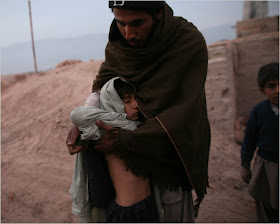 The New York Times
The New York Times
By MICHAEL KAMBER
Published: March 15, 2011
WATA POOR, Afghanistan — The labour boss stood looking down at a man and his four sons squatting in the dirt, the boys mechanically rolling and slapping mud as they made line after line of dull gray bricks.
“See, there’s a sad story,” the boss, Gul Bacha, said as he pointed to the oldest son, Nick Muhammad, 18. He said the young man had twice escaped to join the Afghan Army, but when his father needed another loan from Mr. Bacha, the boss forced him to bring his son back to work.
“His father came to me asking to borrow more money,” Mr. Bacha said. “I told him: ‘No. You must bring your son back here. Or else bring me the money you owe me and leave the house I have provided you.’ ”
The young Mr. Muhammad listened impassively to the tale of his unhappy return to the kiln in Nangarhar Province.
“I was 7 years old when I started this work,” he said later, when the boss was gone. “My family owed 10,000 rupees then. Today, we owe 150,000 rupees.”
Read more and see the video at the end of the article
The Muhammads are indentured servants, bought and paid for by Gul Bacha, who purchased their contracts from a kiln owner in Pakistan, where they had been living as refugees. Like tens of thousands of Afghans, the Muhammads are trapped in a seemingly endless cycle of poverty that keeps them indebted to their employers — a situation common at many of the dusty brick kilns that dot the countryside, as well as in some other industries, particularly in rural areas.
For a vast majority of workers, there is no escape — for them or for their children, who are bound by their parents’ contracts. Their best hope is that the boss will sell their contract to another kiln, where they might be paid more. No matter what, the loan will follow them. In some cases, children are held as their parents’ collateral.
At the kiln where Nick Muhammad works, his father, Zar Muhammad, 55, said he was haunted by guilt that his children would inherit his debt. His two youngest sons, Gul, 7, and Neyaz, 8, worked beside him in the mud as he spoke.
Neyaz’s hands fly with astonishing speed. But the boy looks worn down, exhausted by 12-hour days that start before dawn.
“I don’t like this job,” he said. “I want to go to school and to become a doctor to serve my people and my country.”
There are 90 kilns in the Surkhrod District alone, with an average of 150 to 200 children working in each one, according to Hajji Mirwais, director of the brick kiln union here.
Zar Muhammad’s troubles began 30 years ago when he took a loan from a kiln owner to marry. (The elaborate marriage and funeral ceremonies expected by Afghans frequently cost several years’ worth of wages, forcing many people to take out loans that they must work off.)
Mr. Muhammad soon realized that his weekly earnings in the kiln left little or no money to pay down the principal. As his family grew, he — like other workers here — found himself having to borrow more money to pay for medicine for his children and other basic needs. His debt to the owner grew greater by the year.
The kiln owner pays Mr. Muhammad and his four sons about $10 for the 2,500 bricks they make in an average day. The owner can usually make $160 selling that many bricks.
“We are slaves here because when you owe someone money, then of course you’re a slave,” said Mir Ali, former director of the All Afghanistan labour union, who works in the kilns with his children. “If we try to raise our voice, then the owner of the brick kilns will tell us to empty their house and go from here.”
Sad Kibir Bacha, the district governor for Surkhrod, said he had recently been transferred to the area and was not familiar with the conditions the workers laboured under. He estimated, however, that at least 5,000 children worked in the kilns in his district.
Thousands of Afghan children are slaves
in brick-making factories
in brick-making factories

No comments:
Post a Comment